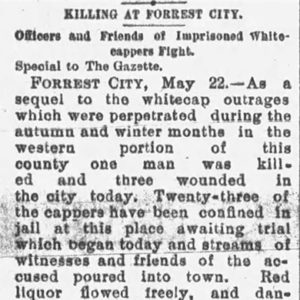calsfoundation@cals.org
J. H. Webster (Murder of)
J. H. Webster was murdered on May 22, 1894, in a shootout at Forrest City (St. Francis County), when he went there to testify in the trial of a group of whitecappers who had been arrested as the result of an investigation he conducted. His death is sometimes included on inventories of lynchings for the state of Arkansas.
J. H. “Harry” Webster was a native of Hardeman County, Tennessee, who had moved to Sheffield, Alabama, to pursue business interests in 1886 before moving to Memphis, Tennessee, in 1893 to begin working as a detective. In late 1893, the sheriff of St. Francis County hired him to investigate a band of whitecappers who had been terrifying African Americans in the western part of the county by committing crimes “such as murder, whipping and house burning.”
The whitecappers were known as Gideon’s Band, and a newspaper wrote that the “pernicious order was in full sway along after Christmas making a specialty of burning houses down over the heads of negroes and performing other playful little feats.”
Webster’s investigation resulted in the arrest of more than twenty accused members of Gideon’s Band, including several “prominent citizens,” for “participating in the burning and outrages which kept St. Francis county at fever heat during the last months of the winter.” Their court date was set for May 22, 1894, in Forrest City, and the sheriff warned Webster that he should come armed when he arrived for the trial.
Webster and a friend, P. D. Gowling, left Memphis on the morning of May 22, 1894, and arrived to find Forrest City full of whitecapper sympathizers who “were all pretty well tanked up, as they began to drink heavily early in the morning.” When the trial took a break at 1:00 p.m., Webster, Gowling, and deputy sheriff Frank Sherman went to Johnson’s saloon, where they found a number of whitecapper sympathizers, including Palestine (St. Francis County) merchant Henry Gore. Webster and Gore “engaged in an altercation,” pistols were drawn, and “almost simultaneously a volley was exchanged.” One source says Gore “applied some insulting epithet” toward Webster, who “demanded that he retract it,” after which Gore shot Webster.
When the smoke cleared, Webster lay mortally wounded, “a bullet having penetrated his bowels.” Sherman had a flesh wound in his chest, a suspender buckle having blocked a bullet, and Gowling and Gore both had arm wounds. Before he died, Webster identified Gore as the man who shot him, and after a coroner’s inquest confirmed that fact, the Palestine merchant was ordered jailed without bond.
The whitecappers’ trial was disrupted as witnesses left Forrest City for fear of being shot. The defendants gained a change of venue, and all were cleared at trials in Phillips County in October and November 1894.
Gore was granted and paid a $5,000 bond in July 1894 and was freed from jail pending his trial for Webster’s death, which was scheduled for September but was postponed until the next spring “on account of the absence of witnesses for the defendant.” Gore died at his home on February 25, 1895, so no one was ever tried for the murder of J. H. Webster.
For additional information:
“Admitted to Bail.” Osceola Times, July 14, 1894, p. 3.
“Another Account.” Arkansas Gazette, May 23, 1894, p. 1.
“Arkansas News.” Arkansas Gazette, October 30, 1894, p. 1.
“The Gore Case Postponed.” Memphis, Tennessee, Commercial Appeal, September 25, 1894, p. 1.
“Henry Gore Is Dead.” Commercial Appeal, March 1, 1895, p. 8.
“J. W. [sic] Webster of Hardeman County, Shot in Arkansas.” Bolivar [Tennessee] Bulletin, June 1, 1894, p. 3.
“Killing at Forrest City.” Arkansas Gazette, May 23, 1894, p. 1.
“One Killed and Three Wounded.” Webster County Argus (Red Cloud, Nebraska), May 31, 1894, p. 2.
“Shot by White Caps.” Commercial Appeal, May 23, 1894, p. 1.
Mark K. Christ
Central Arkansas Library System
 Law
Law Post-Reconstruction through the Gilded Age, 1875 through 1900
Post-Reconstruction through the Gilded Age, 1875 through 1900 J. H. Webster Murder Article
J. H. Webster Murder Article 




Comments
No comments on this entry yet.